- TOP
- Jean Monnet Activities
- Jean Monnet Chair (Agreement No. 2018・3245 / 004 – 001)
- EVENTS Jean Monnet Chair
- 14-15th July 2023 EU Student Camp
[ Editor: Institute for Industrial Research 8th August, 2023 ]
14-15th July 2023 EU Student Camp
"Visit to Volkswagen Group Japan and Toyota Kaikan Museum "
Date: 14(Fri)to 15(Sat)July 2023
Visiting place:Volkswagen Group Japan, Toyohashi City, and Toyota Kaikan Museum, Toyota City
Coordinator:Prof. Holger Bungsche
Number of Participants:14
Objectives of Visit:
Toyota and Volkswagen are the two largest car manufacturers in the world. Both together are manufacturing roughly 20% of all cars in the world. Given the fact that the automobile industry has to abandon its core technology, the Internal Combustion Engine, the visit to Volkswagen Group Japan and Toyota should give students an insight into the state of these two manufacturers and the state of the automobile in Europe (Germany) and Japan.
<Day 1> Volkswagen Group Japan (VGJ)
Outline:
Volkswagen Group Japan (VGJ) is the exclusive importer of four passenger car brands of the Volkswagen group as well as cars of the Porsche brand. The four brands are Volkswagen, Audi, Bentley and Lamborghini.
The first Volkswagen was imported into Japan in 1953. Until the early 1980s Volkswagen and Audi cars were imported by Yanase, a brand independent Japanese importer.
VGJ was established on the 7th of July 1983 in order to strengthen car imports and to distribute Volkswagen group car brands through an exclusive VW and Audi dealer network in Japan.
The site of the Toyohashi Import Centre was acquired in 1990 and import of cars began in 1993 as import operations were relocated from Tokyo to Toyohashi. In 2010, VGJ had imported 1 million cars (VW and Audi cars combined). In 2013, VGJ reported the import of 1 million Volkswagen cars.
Currently VGJ directly employs 140 employees. At the Technical Service Centre (TSC) additional 159 employees are employed by subcontractors, and another 160 people work in the Parts Deposit facilities.
Based on data from JAIA (Japan Automobile Importers Association) total imports of Volkswagen group cars amounted to roughly 60000 cars in 2022. Based on car brands import figures were as below:
Audi: 20750 cars (6.7% share in imported cars)
Bentley: 651 cars (0.2%)
Lamborghini: 571 cars (0.2%)
VW: 32229 cars (10.4%)
Porsche: 7193 cars (2.3%)
Although Volkswagen operates roughly 130 productions sites worldwide, imports to Japan are just conducted from two ports in Europe (Germany and Spain), and one Mexico and South Africa respectively.
Contents of the Visit:
During a roughly 2 hours company tour we were shown all relevant stages from downloading the cars from the incoming ships in the harbour to delivery of the cars to the VW dealerships.
1. Downloading area in the vicinity of the harbour.
2. VW Technical Service Centre (TSC)
3. Spare Parts Centre
4. Training Centre
(1) The cars arrive per ship from the four ports of origin mentioned above. The cars of the brands VW, Audi and Porsche are covered with a protection cover, while the premium cars are shipped in wood containers for additional protection. Usually a ship contains 2000 cars, which takes 3 days to unload. VGJ Toyohashi has a capacity to handle about 6000 cars at one time.
(2) In the technical centre the students were able to see the whole final check and test, all cars must undergo before being distributed to the dealerships. The checks are conducted in four lines, each for every imported brand.
(3) At the parts dept the students were informed how the spare parts arrive, are stored and distributed basically according to size, and frequency of turnover.
(4) The manager of the training centre finally talked about the influence of COVID on the training centre’s activities, and that particular the sales persons’ training is also after COVID conducted mainly online, while training for the maintenance and repair personal of the dealers is again conducted mainly in person at VGJ in Toyohashi.
At the end of our visit to VGJ, the human resource department organized a discussion round with three high-ranking managers n the topic of intercultural management, which was in particular interesting for our students, since they were presented with the view of German managers, who work here in Japan dealing with a different work culture.
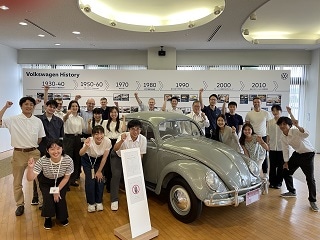

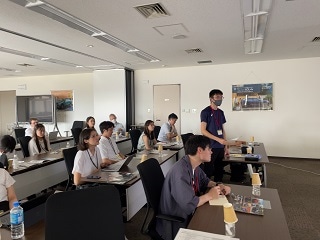
<Day 2>Toyota Kaikan Museum
Outline:
Toyota Kaikan Museum Toyota has established the Toyota Kaikan Museum 20 years ago. The cncept of the Toyota Kaikan Museum is somehow different from a conventional museum as there are not really historical cars exhibited, but the Kaikan is presenting several larger issues related to the development of the Toyota company like for instance the specific Toyota Way of production. Other big issues are related to the safety of cars, future propulsion technologies, efforts to reduce the environmental impact of cars and to achieve sustainability of the industry, as well as the car as a means of stabilizing the electricity infrastructure in the aftermath of natural disasters. Many of these topics and concepts were developed over a long period of time and already displayed at past motor shows, particular in Tokyo.
Contents of the Visit:
Toyota Kaikan Museum With respect to the challenges the automobile industry is facing, the issues of new ways of mobility (Toyota as a Mobility Company), future propulsion technologies, in particular the hydrogen engine as well as car safety (zero accidents) were especially interesting. The main focus of the Kaikan exhibition was indeed on future engine technologies with a special emphasis on the hydrogen engine (fuel-cell). Surprisingly besides a new concept car of a future Prius, there was not much any longer on the further development of the hybrid or plug-in hybrid engine. This is remarkable, since no other car manufacturer is really focusing on hydrogen, at least not as a solution for the nearer future. Unfortunately, there was not much new to see with respect to Toyota’s vision for future mobility and especially the Woven City Concept. Nevertheless, the Kaikan left the strong impression that Toyota is indeed at the moment the only company that does not just see the solution to global warming in replacing the ICE engine with an electric motor, but thinks about new and more intelligent ways to organize and realize future auto-mobility. The question, however, remained particular when looking at the current model line of Toyota as displayed in the last rom of the Kaikan, whether the shift to new forms of mobility will be customer driven, or whether or not it has to be pushed forward by regulations.
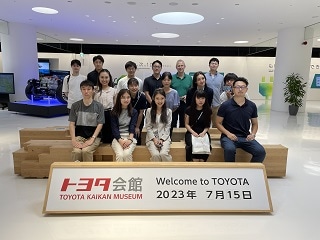
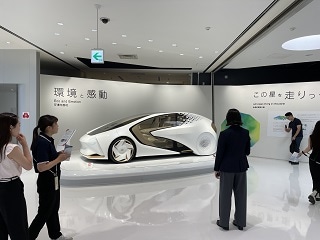
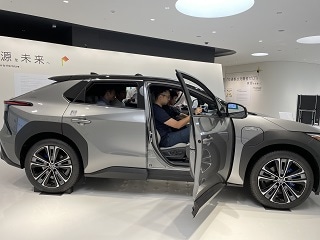
Students Comments:
Several students shared their thoughts on the visit. One student expressed admiration for the diligence exhibited by Volkswagen Group Japan in preparing each car before delivery, elevating their esteem for the company. Another student praised the safety simulator at the Toyota Kaikan Museum, providing a valuable hands-on experience with safety functions activated during simulated driving situations. This experience was considered invaluable compared to a classroom setting, and the student expressed interest in learning more about the technical mechanisms behind automatic braking.
Conclusion:
The visit to Volkswagen Group Japan and Toyota Kaikan Museum proved to be highly insightful and beneficial for the participating students. We hope to organize similar events in the future to offer more students the opportunity to gain practical knowledge and insights into the global automobile industry.

